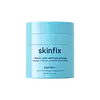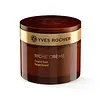What's inside
What's inside
 Key Ingredients
Key Ingredients

 Benefits
Benefits

 Concerns
Concerns

 Ingredients Side-by-side
Ingredients Side-by-side

Water
Skin ConditioningCaprylic/Capric Triglyceride
MaskingGlycerin
HumectantButyrospermum Parkii Butter
Skin ConditioningOlus Oil
EmollientCetyl Lactate
EmollientPropanediol
SolventC12-16 Alcohols
EmollientCaprylyl Caprylate/Caprate
EmollientJojoba Oil/Macadamia Seed Oil Esters
Skin ConditioningGlyceryl Stearate Citrate
EmollientPalmitic Acid
EmollientHydrogenated Lecithin
EmulsifyingOryza Sativa Bran Extract
Skin ConditioningDilinoleic Acid/Propanediol Copolymer
EmollientSqualene
EmollientOphiopogon Japonicus Root Extract
Skin ConditioningXanthan Gum
EmulsifyingPhytosteryl Sunflowerseedate
Skin ConditioningGlycine Soja Extract
Skin ConditioningPentylene Glycol
Skin ConditioningCeramide NP
Skin ConditioningCeramide AP
Skin ConditioningCeramide EOP
Skin ConditioningHydrolyzed Rice Protein
Skin ConditioningChondrus Crispus Extract
Skin ConditioningHydrogenated Vegetable Glycerides
EmollientHelianthus Annuus Extract
EmollientSodium Hyaluronate
HumectantCitric Acid
BufferingPhytosteryl Macadamiate
Skin ConditioningTocopherol
AntioxidantRosmarinus Officinalis Leaf Extract
AntimicrobialAloe Barbadensis Leaf Juice
Skin ConditioningTrisodium Ethylenediamine Disuccinate
Phytosterols
Skin ConditioningSodium Lauroyl Lactylate
EmulsifyingGluconolactone
Skin ConditioningPhenethyl Alcohol
MaskingPhytosphingosine
Skin ConditioningCholesterol
EmollientCarbomer
Emulsion StabilisingPotassium Sorbate
PreservativeEthylhexylglycerin
Skin ConditioningSodium Benzoate
MaskingPhenoxyethanol
PreservativeWater, Caprylic/Capric Triglyceride, Glycerin, Butyrospermum Parkii Butter, Olus Oil, Cetyl Lactate, Propanediol, C12-16 Alcohols, Caprylyl Caprylate/Caprate, Jojoba Oil/Macadamia Seed Oil Esters, Glyceryl Stearate Citrate, Palmitic Acid, Hydrogenated Lecithin, Oryza Sativa Bran Extract, Dilinoleic Acid/Propanediol Copolymer, Squalene, Ophiopogon Japonicus Root Extract, Xanthan Gum, Phytosteryl Sunflowerseedate, Glycine Soja Extract, Pentylene Glycol, Ceramide NP, Ceramide AP, Ceramide EOP, Hydrolyzed Rice Protein, Chondrus Crispus Extract, Hydrogenated Vegetable Glycerides, Helianthus Annuus Extract, Sodium Hyaluronate, Citric Acid, Phytosteryl Macadamiate, Tocopherol, Rosmarinus Officinalis Leaf Extract, Aloe Barbadensis Leaf Juice, Trisodium Ethylenediamine Disuccinate, Phytosterols, Sodium Lauroyl Lactylate, Gluconolactone, Phenethyl Alcohol, Phytosphingosine, Cholesterol, Carbomer, Potassium Sorbate, Ethylhexylglycerin, Sodium Benzoate, Phenoxyethanol
Water
Skin ConditioningGlycerin
HumectantMethylpropanediol
SolventEthylhexyl Stearate
EmollientCocos Nucifera Oil
MaskingDimethicone
EmollientBrassica Campestris Seed Oil
Skin ConditioningSteareth-2
EmulsifyingHelianthus Annuus Seed Oil
EmollientMacadamia Ternifolia Seed Oil
EmollientGlyceryl Stearate
EmollientSteareth-21
CleansingHydrogenated Coconut Oil
EmollientCoco-Caprylate/Caprate
EmollientStearyl Alcohol
EmollientSimmondsia Chinensis Seed Oil
EmollientCentaurea Cyanus Flower Water
Skin ConditioningButyrospermum Parkii Butter
Skin ConditioningCandelilla Cera
EmollientAphloia Theiformis Leaf Extract
AstringentSesamum Indicum Seed Oil
EmollientPhenoxyethanol
PreservativeParfum
MaskingXanthan Gum
EmulsifyingOlea Europaea Fruit Oil
MaskingEthyl Linoleate
EmollientZea Mays Germ Oil
EmollientRicinus Communis Seed Oil
MaskingPrunus Amygdalus Dulcis Oil
Skin ConditioningCorylus Avellana Seed Oil
EmollientCarthamus Tinctorius Seed Oil
MaskingRetinyl Palmitate
Skin ConditioningGlycine Soja Sterols
EmollientLecithin
EmollientTocopheryl Acetate
AntioxidantSorbic Acid
PreservativePrunus Persica Kernel Oil
EmollientPrunus Armeniaca Kernel Oil
MaskingPistacia Vera Seed Oil
Skin ConditioningPersea Gratissima Oil
Skin ConditioningOryza Sativa Germ Oil
EmollientOrbignya Oleifera Seed Oil
EmollientMangifera Indica Seed Oil
EmollientJuglans Regia Seed Oil
Skin ConditioningGossypium Herbaceum Seed Oil
Skin ConditioningCamellia Oleifera Seed Oil
Skin ConditioningBHT
AntioxidantSilybum Marianum Seed Oil
Skin ConditioningRosa Canina Fruit Oil
EmollientOenothera Biennis Seed Extract
Skin ConditioningLimnanthes Alba Seed Oil
Skin ConditioningCarapa Guaianensis Seed Oil
Skin ConditioningCamelina Sativa Seed Oil
Skin ConditioningArgania Spinosa Kernel Oil
EmollientTetrasodium EDTA
Sodium Hydroxide
BufferingRosa Damascena Extract
MaskingSodium Benzoate
MaskingTocopherol
AntioxidantPotassium Sorbate
PreservativeCitric Acid
BufferingCitronellol
PerfumingAlcohol
AntimicrobialPropyl Gallate
AntioxidantWater, Glycerin, Methylpropanediol, Ethylhexyl Stearate, Cocos Nucifera Oil, Dimethicone, Brassica Campestris Seed Oil, Steareth-2, Helianthus Annuus Seed Oil, Macadamia Ternifolia Seed Oil, Glyceryl Stearate, Steareth-21, Hydrogenated Coconut Oil, Coco-Caprylate/Caprate, Stearyl Alcohol, Simmondsia Chinensis Seed Oil, Centaurea Cyanus Flower Water, Butyrospermum Parkii Butter, Candelilla Cera, Aphloia Theiformis Leaf Extract, Sesamum Indicum Seed Oil, Phenoxyethanol, Parfum, Xanthan Gum, Olea Europaea Fruit Oil, Ethyl Linoleate, Zea Mays Germ Oil, Ricinus Communis Seed Oil, Prunus Amygdalus Dulcis Oil, Corylus Avellana Seed Oil, Carthamus Tinctorius Seed Oil, Retinyl Palmitate, Glycine Soja Sterols, Lecithin, Tocopheryl Acetate, Sorbic Acid, Prunus Persica Kernel Oil, Prunus Armeniaca Kernel Oil, Pistacia Vera Seed Oil, Persea Gratissima Oil, Oryza Sativa Germ Oil, Orbignya Oleifera Seed Oil, Mangifera Indica Seed Oil, Juglans Regia Seed Oil, Gossypium Herbaceum Seed Oil, Camellia Oleifera Seed Oil, BHT, Silybum Marianum Seed Oil, Rosa Canina Fruit Oil, Oenothera Biennis Seed Extract, Limnanthes Alba Seed Oil, Carapa Guaianensis Seed Oil, Camelina Sativa Seed Oil, Argania Spinosa Kernel Oil, Tetrasodium EDTA, Sodium Hydroxide, Rosa Damascena Extract, Sodium Benzoate, Tocopherol, Potassium Sorbate, Citric Acid, Citronellol, Alcohol, Propyl Gallate
 Reviews
Reviews

Ingredients Explained
These ingredients are found in both products.
Ingredients higher up in an ingredient list are typically present in a larger amount.
This ingredient is also known as shea butter. It is an effective skin hydrator and emollient.
Emollients help soothe and soften your skin. It does this by creating a protective film on your skin. This barrier helps trap moisture and keeps your skin hydrated. Emollients may be effective at treating dry or itchy skin.
Shea butter is rich in antioxidants. Antioxidants help fight free-radicals, or molecules that may harm the body. It is also full of fatty acids including stearic acid and linoleic acid. These acids help replenish the skin and keep skin moisturized.
While Shea Butter has an SPF rating of about 3-4, it is not a sunscreen replacement.
Shea butter may not be fungal acne safe. We recommend speaking with a professional if you have any concerns.
Learn more about Butyrospermum Parkii ButterCitric Acid is an alpha hydroxy acid (AHA) naturally found in citrus fruits like oranges, lemons, and limes.
Like other AHAs, citric acid can exfoliate skin by breaking down the bonds that hold dead skin cells together. This helps reveal smoother and brighter skin underneath.
However, this exfoliating effect only happens at high concentrations (20%) which can be hard to find in cosmetic products.
Due to this, citric acid is usually included in small amounts as a pH adjuster. This helps keep products slightly more acidic and compatible with skin's natural pH.
In skincare formulas, citric acid can:
While it can provide some skin benefits, research shows lactic acid and glycolic acid are generally more effective and less irritating exfoliants.
Most citric acid used in skincare today is made by fermenting sugars (usually from molasses). This synthetic version is identical to the natural citrus form but easier to stabilize and use in formulations.
Read more about some other popular AHA's here:
Learn more about Citric AcidGlycerin is already naturally found in your skin. It helps moisturize and protect your skin.
A study from 2016 found glycerin to be more effective as a humectant than AHAs and hyaluronic acid.
As a humectant, it helps the skin stay hydrated by pulling moisture to your skin. The low molecular weight of glycerin allows it to pull moisture into the deeper layers of your skin.
Hydrated skin improves your skin barrier; Your skin barrier helps protect against irritants and bacteria.
Glycerin has also been found to have antimicrobial and antiviral properties. Due to these properties, glycerin is often used in wound and burn treatments.
In cosmetics, glycerin is usually derived from plants such as soybean or palm. However, it can also be sourced from animals, such as tallow or animal fat.
This ingredient is organic, colorless, odorless, and non-toxic.
Glycerin is the name for this ingredient in American English. British English uses Glycerol/Glycerine.
Learn more about GlycerinPhenoxyethanol is a preservative that has germicide, antimicrobial, and aromatic properties. Studies show that phenoxyethanol can prevent microbial growth. By itself, it has a scent that is similar to that of a rose.
It's often used in formulations along with Caprylyl Glycol to preserve the shelf life of products.
Potassium Sorbate is a preservative used to prevent yeast and mold in products. It is commonly found in both cosmetic and food products.
This ingredient comes from potassium salt derived from sorbic acid. Sorbic acid is a natural antibiotic and effective against fungus.
Both potassium sorbate and sorbic acid can be found in baked goods, cheeses, dried meats, dried fruit, ice cream, pickles, wine, yogurt, and more.
You'll often find this ingredient used with other preservatives.
Learn more about Potassium SorbateSodium Benzoate is a preservative. It's used in both cosmetic and food products to inhibit the growth of mold and bacteria. It is typically produced synthetically.
Both the US FDA and EU Health Committee have approved the use of sodium benzoate. In the US, levels of 0.1% (of the total product) are allowed.
Sodium benzoate works as a preservative by inhibiting the growth of bacteria inside of cells. It prevents the cell from fermenting a type of sugar using an enzyme called phosphofructokinase.
It is the salt of benzoic acid. Foods containing sodium benzoate include soda, salad dressings, condiments, fruit juices, wines, and snack foods.
Studies for using ascorbic acid and sodium benzoate in cosmetics are lacking, especially in skincare routines with multiple steps.
We always recommend speaking with a professional, such as a dermatologist, if you have any concerns.
Learn more about Sodium BenzoateTocopherol (also known as Vitamin E) is a common antioxidant used to help protect the skin from free-radicals and strengthen the skin barrier. It's also fat soluble - this means our skin is great at absorbing it.
Vitamin E also helps keep your natural skin lipids healthy. Your lipid skin barrier naturally consists of lipids, ceramides, and fatty acids. Vitamin E offers extra protection for your skin’s lipid barrier, keeping your skin healthy and nourished.
Another benefit is a bit of UV protection. Vitamin E helps reduce the damage caused by UVB rays. (It should not replace your sunscreen). Combining it with Vitamin C can decrease sunburned cells and hyperpigmentation after UV exposure.
You might have noticed Vitamin E + C often paired together. This is because it is great at stabilizing Vitamin C. Using the two together helps increase the effectiveness of both ingredients.
There are often claims that Vitamin E can reduce/prevent scarring, but these claims haven't been confirmed by scientific research.
Learn more about TocopherolWater. It's the most common cosmetic ingredient of all. You'll usually see it at the top of ingredient lists, meaning that it makes up the largest part of the product.
So why is it so popular? Water most often acts as a solvent - this means that it helps dissolve other ingredients into the formulation.
You'll also recognize water as that liquid we all need to stay alive. If you see this, drink a glass of water. Stay hydrated!
Learn more about WaterXanthan gum is used as a stabilizer and thickener within cosmetic products. It helps give products a sticky, thick feeling - preventing them from being too runny.
On the technical side of things, xanthan gum is a polysaccharide - a combination consisting of multiple sugar molecules bonded together.
Xanthan gum is a pretty common and great ingredient. It is a natural, non-toxic, non-irritating ingredient that is also commonly used in food products.
Learn more about Xanthan Gum